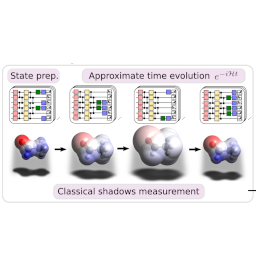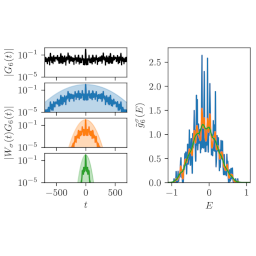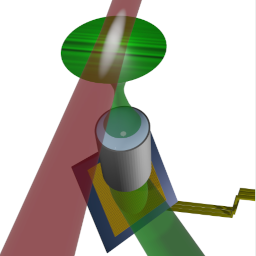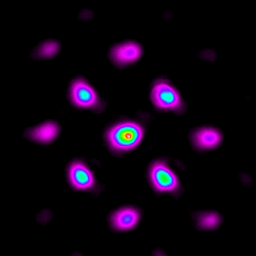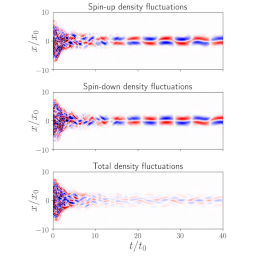publications
publications by categories in reversed chronological order. generated by jekyll-scholar.
2025
- Phys. Rev. Res.
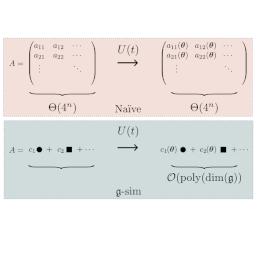 Lie-algebraic classical simulations for quantum computingMatthew L Goh, Martin Larocca, Lukasz Cincio, M Cerezo, and Frédéric SauvagePhysical Review Research, 2025
Lie-algebraic classical simulations for quantum computingMatthew L Goh, Martin Larocca, Lukasz Cincio, M Cerezo, and Frédéric SauvagePhysical Review Research, 2025The classical simulation of quantum dynamics plays an important role in our understanding of quantum complexity and in the development of quantum technologies. Efficient techniques such as those based on the Gottesman-Knill theorem for Clifford circuits, tensor networks for low entanglement-generating circuits, or Wick’s theorem for fermionic Gaussian states have become central tools in quantum computing. In this work, we contribute to this body of knowledge by presenting a framework for classical simulations, dubbed “𝔤-sim”, which is based on the underlying Lie algebraic structure of the dynamical process. When the dimension of the algebra grows at most polynomially in the system size, there exist observables for which the simulation is efficient. Indeed, we show that 𝔤-sim enables new regimes for classical simulations, is able to deal with certain forms of noise in the evolution, as well as can be used to tackle several paradigmatic variational and nonvariational quantum computing tasks. For the former, we perform Lie-algebraic simulations to train and optimize parametrized quantum circuits (thus effectively showing that some variational models can be dequantized), design enhanced parameter initialization strategies, solve tasks of quantum circuit synthesis, and train a quantum-phase classifier. For the latter, we report large-scale noiseless and noisy simulations on benchmark problems. By comparing the limitations of 𝔤-sim and certain Wick’s theorem-based simulations, we find that the two methods become inefficient for different types of states or observables, hinting at the existence of distinct, nonequivalent resources for classical simulation.
- More buck-per-shot: Why learning trumps mitigation in noisy quantum sensingAroosa Ijaz, C Huerta Alderete, Frédéric Sauvage, Lukasz Cincio, Marco Cerezo, and Matthew L GohMaterials Today Quantum, 2025
Quantum sensing is one of the most promising applications for quantum technologies. However, reaching the ultimate sensitivities enabled by the laws of quantum mechanics can be a challenging task in realistic scenarios where noise is present. While several strategies have been proposed to deal with the detrimental effects of noise, these come at the cost of an extra shot budget. Given that shots are a precious resource for sensing - as infinite measurements could lead to infinite precision - care must be taken to truly guarantee that any shot not being used for sensing is actually leading to some metrological improvement. In this work, we study whether investing shots in error-mitigation, inference techniques, or combinations thereof, can improve the sensitivity of a noisy quantum sensor on a (shot) budget. We present a detailed bias-variance error analysis for various sensing protocols. Our results show that the costs of zero-noise extrapolation techniques outweigh their benefits. We also find that pre-characterizing a quantum sensor via inference techniques leads to the best performance, under the assumption that the sensor is sufficiently stable.
- Quantum Sci. Technol.
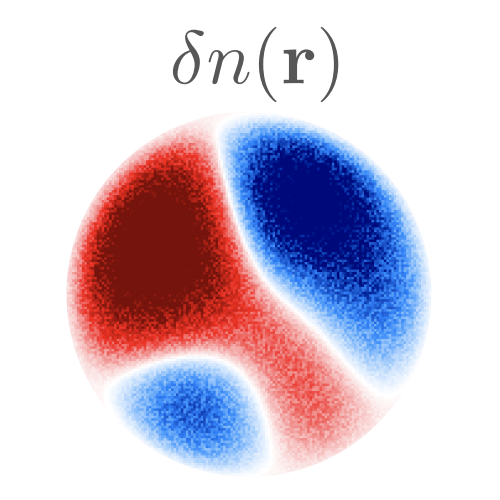 Multi-mode cooling of a Bose-Einstein condensate with linear quantum feedbackZain Mehdi, Matthew L Goh, Matthew J Blacker, Joseph J Hope, and Stuart S SzigetiQuantum Science and Technology, 2025
Multi-mode cooling of a Bose-Einstein condensate with linear quantum feedbackZain Mehdi, Matthew L Goh, Matthew J Blacker, Joseph J Hope, and Stuart S SzigetiQuantum Science and Technology, 2025We theoretically investigate measurement-based feedback control over the motional degrees of freedom of an oblate quasi-2D atomic Bose-Einstein condensate (BEC) subject to continuous density monitoring. We develop a linear-quadratic-Gaussian (LQG) model that describes the multi-mode dynamics of the condensate’s collective excitations under continuous measurement and control. Crucially, the multi-mode cold-damping feedback control we consider uses a realistic state-estimation scheme that does not rely upon a particular model of the atomic dynamics. We present analytical results showing that collective excitations can be cooled to below single-phonon average occupation (ground-state cooling) across a broad parameter regime and identify the conditions under which the lowest steady-state phonon occupation is asymptotically achieved. Further, we develop multi-objective optimization methods that explore the trade-off between cooling speed and the final energy of the cloud and provide numerical simulations demonstrating the ground-state cooling of the lowest ten motional modes above the condensate ground state. Our investigation provides concrete guidance on the feedback control design and parameters needed to experimentally realize a feedback-cooled BEC.
2024
- Direct Estimation of the Density of States for Fermionic SystemsMatthew L Goh, and Bálint KoczorarXiv preprint arXiv:2407.03414, 2024
Simulating time evolution is one of the most natural applications of quantum computers and is thus one of the most promising prospects for achieving practical quantum advantage. Here we develop quantum algorithms to extract thermodynamic properties by estimating the density of states (DOS), a central object in quantum statistical mechanics. We introduce key innovations that significantly improve the practicality and extend the generality of previous techniques. First, our approach allows one to estimate the DOS for a specific subspace of the full Hilbert space. This is crucial for fermionic systems, since fermion-to-qubit mappings partition the full Hilbert space into subspaces of fixed number, on which both canonical and grand canonical ensemble properties depend. Second, in our approach, by time evolving very simple, random initial states (e.g. random computational basis states), we can exactly recover the DOS on average. Third, due to circuit-depth limitations, we only reconstruct the DOS up to a convolution with a Gaussian window - thus all imperfections that shift the energy levels by less than the width of the convolution window will not significantly affect the estimated DOS. For these reasons we find the approach is a promising candidate for early quantum advantage as even short-time, noisy dynamics yield a semi-quantitative reconstruction of the DOS (convolution with a broad Gaussian window), while early fault tolerant devices will likely enable higher resolution DOS reconstruction through longer time evolution. We demonstrate the practicality of our approach in representative Fermi-Hubbard and spin models and find that our approach is highly robust to algorithmic errors in the time evolution and to gate noise. We show that our approach is compatible with NISQ-friendly variational methods, introducing a new technique for variational time evolution in noisy DOS computations.
- Protocols and applications for imperfect quantum devicesMatthew L. Goh2024
Merton College awards a handful of Graduate Prize Scholarships to later-year postgraduate research students, recognizing “those of the highest academic distinction”. I was named a Prize Scholar in the 2024-25 cohort in recognition of my doctoral research.
Quantum computing is a rapidly advancing field that, if fully realized, promises to be revolutionary for applications including drug discovery, optimization, and cryptography. However, the challenges remaining to achieve this dream are considerable. Today’s quantum computers (and those the foreseeable near future) are plagued by limited system sizes, decoherence, faulty operations, and a variety of other issues that have thus far inhibited quantum advantage on genuinely useful problems. While others pursue the ultimate goal of fully-fault-tolerant quantum computing, this thesis is about learning to live with these limitations, and to extract useful information from imperfect, noisy devices with no or limited quantum error correction. In this thesis, I introduce new algorithms that are resilient to these effects, study protocols that can best compensate for them, and probe the boundaries between quantum and classical systems. This thesis spans three rather distinct topics in quantum technology: the use of imperfect quantum computers to study quantum systems; classically-efficient simulation of quantum devices; and quantum sensing in the presence of noise. I introduce new protocols and algorithms for each of these areas, and support them with both mathematical study and computer simulations. Broadly speaking, the contributions of this thesis are as follows. I introduce a new algorithm for resource-efficient estimation of excitation energies in quantum systems, studying its near-term applicability and scalability. I develop a new method for computing thermal properties of quantum systems on quantum computers, which appears particularly applicable to the early-fault-tolerant era, and expands upon previous approaches in both the resources required and the systems it can be applied to. I introduce a new classical simulation framework for variational quantum algorithms, expanding the domain of classically simulable problems in quantum computing, and demonstrate its application to archetypal problems in variational quantum computing and quantum machine learning. Finally, I compare protocols that compensate for the presence of noise in quantum sensing, showing that learning-based techniques are particularly promising.
2023
- Enhancing the sensitivity of atom-interferometric inertial sensors using robust controlJack C Saywell, Max S Carey, Philip S Light, Stuart S Szigeti, Alistair R Milne, Karandeep S Gill, Matthew L Goh, Viktor S Perunicic, Nathanial M Wilson, Calum D Macrae, and othersNature Communications, 2023
Atom-interferometric quantum sensors could revolutionize navigation, civil engineering, and Earth observation. However, operation in real-world environments is challenging due to external interference, platform noise, and constraints on size, weight, and power. Here we experimentally demonstrate that tailored light pulses designed using robust control techniques mitigate significant error sources in an atom-interferometric accelerometer. To mimic the effect of unpredictable lateral platform motion, we apply laser-intensity noise that varies up to 20% from pulse-to-pulse. Our robust control solution maintains performant sensing, while the utility of conventional pulses collapses. By measuring local gravity, we show that our robust pulses preserve interferometer scale factor and improve measurement precision by 10x in the presence of this noise. We further validate these enhancements by measuring applied accelerations over a 200μg range up to 21x more precisely at the highest applied noise level. Our demonstration provides a pathway to improved atom-interferometric inertial sensing in real-world settings.
2022
- Feedback cooling Bose gases to quantum degeneracyMatthew L Goh, Zain Mehdi, Richard L Taylor, Ryan J Thomas, Ashton S Bradley, Michael R Hush, Joseph J Hope, and Stuart S SzigetiarXiv preprint arXiv:2206.05069, 2022
Degenerate quantum gases are instrumental in advancing many-body quantum physics and underpin emerging precision sensing technologies. All state-of-the-art experiments use evaporative cooling to achieve the ultracold temperatures needed for quantum degeneracy, yet evaporative cooling is extremely lossy: more than 99.9% of the gas is discarded. Such final particle number limitations constrain imaging resolution, gas lifetime, and applications leveraging macroscopic quantum coherence. Here we show that atomic Bose gases can be cooled to quantum degeneracy using real-time feedback, an entirely new method that does not suffer the same limitations as evaporative cooling. Through novel quantum-field simulations and scaling arguments, we demonstrate that an initial low-condensate-fraction thermal Bose gas can be cooled to a high-purity Bose-Einstein condensate (BEC) by feedback control, with substantially lower atomic loss than evaporative cooling. Advantages of feedback cooling are found to be robust to imperfect detection, finite resolution of the control and measurement, time delay in the control loop, and spontaneous emission. Using feedback cooling to create degenerate sources with high coherence and low entropy enables new capabilities in precision measurement, atomtronics, and few- and many-body quantum physics.
2020
- Improved phase locking of laser arrays with nonlinear couplingSimon Mahler, Matthew L Goh, Chene Tradonsky, Asher A Friesem, and Nir DavidsonPhysical Review Letters, 2020
This article was selected as a PRL Editor’s Suggestion. About one Letter in six is chosen for this highlighting of work judged by the Editors to be particularly important, interesting, and well written.
An arrangement based on a degenerate cavity laser for forming an array of nonlinearly coupled lasers with an intracavity saturable absorber is presented. More than 30 lasers were spatially phase locked and temporally Q switched. The arrangement with nonlinear coupling was found to be 25 times more sensitive to loss differences and converged five times faster to the lowest loss phase locked state than with linear coupling, thus providing a unique solution to problems that have several near-degenerate solutions.
2019
- Feedback control of atomic Fermi gasesMatthew L. Goh2019
I received the TH Laby Medal from the Australian Institute of Physics, recognizing the best physics Honours or Masters thesis in Australia.
Ultracold atomic Fermi gases are the leading platform for analogue quantum simulation, and provide a promising avenue to study the origin of high-temperature superconductivity in cuprates. However, current experimental approaches to cooling Fermi gases use evaporative cooling, which is limited by poor thermalisation properties of fermions and is non-number-conserving. This prevents the creation of useful analogue simulators of many collective phenomena. This thesis is the first theoretical investigation into the use of continuous-measurement feedback control as an alternative means of cooling an atomic Fermi gas. Since tractable simulation of Fermi gas dynamics requires simplifications to the full quantum field theory, we derive and simulate a fermionic equivalent to the Gross-Pitaevskii equation, generalising a model of feedback-controlled BECs by Haine et al. to multimode ultracold atomic Fermi gases. We demonstrate that in the absence of measurement effects, a suitable control can drive an interacting Fermi gas arbitrarily close to its ground state. However, although control schemes based upon damping spatial density fluctuations work well for single-spatial-mode BECs, we show that they perform poorly for Fermi gases with a large number of atoms due to counter-oscillation of multiple spatial modes, which must exist due to Pauli exclusion. We generalise a feedback-measurement model of BECs by Szigeti et al. to a multimode atomic Fermi gas, and perform stochastic simulations of measured, feedback-controlled fermions in the single-atom and many-atom mean-field limits. The effects of measurement backaction are an important consideration, since in a realistic experiment knowledge of the system state used for feedback must be obtained from measurement, leading to competition between measurement-induced heating and feedback cooling. We show that weaker and less precise measurements cool the system to a lower equilibrium excitation energy, but are unable to place practical lower bounds on measurement strength due to the lack of a system-filter separation. When measurement-induced heating is accounted for, we find that the equilibrium energy per particle scales superlinearly, suggesting that existing control schemes which work well for bosons would not be effective for fermions. In light of this, we propose several avenues of future investigation to overcome this limitation, leaving open the possibility of feedback control of atomic Fermi gases as a pathway to analogue quantum simulation.
